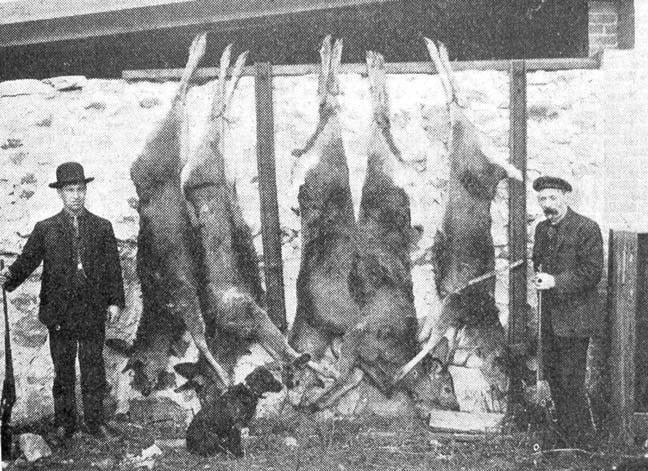Jim Cameron
The East Kootenay has long been known as one of the best hunting and fishing districts in North America. From the time of the earliest hunters and trappers to the days of the Wild Horse gold rush, white settlers soon discovered what the natives had known for millennia: if you're looking for game, the East Kootenay is the place to go.
Local Cranbrook resident Charles M. Edwards (for whom Edwards Street is named), wrote, in a letter of May 16, 1907, to Bryan Williams, Chief Game Warden of B.C., of the early days of hunting in the district:
"It will be my endeavor to lay before you as fair an account as possible of conditions past and present ... In 1886, the year in which I came to the south east Kootenay ... it was the customs of the St. Mary's, Windermere and Tobacco Plains Indians to go to Fisher River, now Jennings, Montana, for their fall hunt, and the last few days of October would see droves of empty pack horses driven across the International boundary for the fall hunt. The Indians would camp there and wait for the first snow, which brought the mule deer within easy distance of camp ... They came in literally by the thousand ... one would have to see them to believe that such numbers of deer still existed in one section. The deer were killed by the hundred, as 40 to each of the 75 to 100 hunters was by no means a high average, and the meat was dried and packed home for winter food.
"The advent of the Great Northern [railway] was the means of bringing in white settlers and it was, I think, about 1896, that the first prosecution of B.C. Indians was taken, and consequent on this the B.C. Indians had to hunt and endeavor to obtain an equivalent supply of winter food on their own side of the line ... the hunting grounds being Gold Creek, Elk River, Morrissey, Elko, Sheep Creek and the Upper Kootenay and it is in all these sections that the fearful diminution in numbers is to be noticed."
This was not a revelation at the time. Indeed, the British Columbia government recognized the problem as being province-wide on July 1, 1905, by establishing the Department for the Protection of Game and Forests. Sadly, the number of game wardens was not equal to the size of the territory. It was akin to asking the needle to police the haystack. The fact that there was no real budget and that most the wardens were untrained volunteers did not help.
The diminishing wildlife throughout the province was noted that same year when a provincial petition circulated calling for more stringent regulations as to the killing of game. At that time the single season limit for each hunter was five caribou (bull), five deer, two elk or wapiti (bull), two moose, five mountain goat, three mountain sheep (ram), 250 duck and 250 snipe. Non-residents, other than officers of his majesty's army and navy, were required to purchase a $50 license, and there were plenty of non-residents who did just that.
 Pictured: W.T. Hornaday undertook a rigorous campaign to establish a wildlife preserve in the East Kootenay.
Pictured: W.T. Hornaday undertook a rigorous campaign to establish a wildlife preserve in the East Kootenay.
By 1906, the old-timers were commenting that game had never been so scarce in the district. A suspension of beaver hunting was established in 1905, but the remainder of the animals remained vulnerable.
The above letter from Charles Edwards was on behalf of a proposed East Kootenay game preserve. A Game Protective Association was already active in Fernie but it was a novel idea for the Cranbrook sportsmen.
In April, 1908, a meeting was held at the Cranbrook Hotel to form such an association, with Messrs A. Leitch and C.M. Edwards duly elected as chairman and secretary, respectively. The concept met with a great deal of support and a meeting the following week, supported by members of the Fernie group, saw a large turnout resulting in representatives chosen from Cranbrook, Fort Steele, Maryville, Wardner, Wattsburg, Moyie, Yahk, and Wolf Creek.
It was agreed that members, most of them experienced hunters and fishermen, would do their best to see that all game laws were enforced and that any fines collected by members giving information would be turned over to the association. Further, the association agreed to seek provincial approval regarding the establishment of a game preserve and to meet with the provincial game warden to establish the district.
This is where the Bronx Zoo comes into the picture. Not in the form of animals as one might suppose, but rather in the form of William Temple Hornaday, the first director of the zoo under the New York Zoological Society (which later became the Wildlife Conservation Society).
W. T. Hornaday (1854-1937), an American conservationist, taxidermist and author, was hired to create a world class zoo in New York in 1896 and Mr. Hornaday did just that. In 1905 he spent time in the East Kootenay wilds which not only resulted in a best-selling book, "Camp-Fires in the Canadian Rockies," but the beginnings of what would become a serious campaign on his part to have a game preserve set aside in the East Kootenay. His countless letters and articles won him favour from prominent British Columbian politicians, landowners and the CPR, by stressing the advantages of the tourism generated through the enterprise. He worked closely for a time with the Fernie Game Protective Association although they differed on the location and size of the preserve.
On Nov.15, 1908, B.C. established the Elk River Game Reserve, of approximately 450 square miles between the Bull and Elk Rivers using nearly all of Hornaday's recommendations. As Hornaday stated "whoever aids in preserving from extinction the grand game of British Columbia renders good service to two countries."
